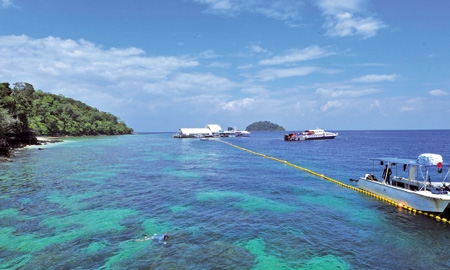
One can always take advantage of the wide variety of activities that Malaysia’s diverse landscape has to offer – from mountain climbing to deep-sea diving, and street food tasting to luxury shopping.
Complementing the list of already established activities, this year the Malaysian government, along with the Association of Hotels, has created an itinerary jam-packed with more than 200 local events and mega festivals, all of which can be found on the VMY 2014 website: www.vmy2014.com
Danny Law Heng Kiang, Penang State Minister for Tourism Development, notes, "Malaysia has allocated many projects and funds to promote Malaysia to the rest of the world." For example, the RM2 billion Special Tourism Fund provides for a tax allowance designed to help improve infrastructure, develop public spaces such as restrooms, and create covered walkways between transit stations. To the delight of Mr Pereira, the government agreed to extend this fund beyond VMY 2014 to the year 2016, following the request by the Association of Hotels.
Regardless of all the hype from VMY 2014, Malaysia has long been a go-to holiday destination for British travellers, with 300,000 visiting the country every year. More than 16,500 British expats, retired and otherwise, currently live and work in the Southeast Asian paradise.
It may be surprising to some that under the Malaysia My Second Home (MM2H) visa programme, foreigners are eligible for a 10-year visa, pending proof of financial stability. With the MM2H visa, citizens receive an identity card, can travel in and out of the country hassle-free, are allowed to purchase property and vehicles, search for employment, and send their children to school. Visa holders can even take advantage of Malaysia’s world-renowned medical care service, a system to which foreigners practicing medical tourism contribute 60 per cent of its total revenue.
Many expats under this programme choose to build their second home in Penang State. In 2007 Islands
For the Tourism Minister, Penang is a unique area of Malaysia. "Over 200 years ago, Penang was established as an international port," he says, adding that it was a centre for international trade and an important stop on the spice route. Today the region maintains its warmth and respect for its international community. "It is blessed with such a cultural and ethnic diversity that creates a sort of cosmopolitan social life and it’s very peculiar," he says.
In George Town, the "Street of Harmony" exhibits a Christian church, a Chinese temple, a Muslim mosque and a Hindu temple, all within five minutes walking distance from one another, giving testimony to Penang as a true melting pot. Remarkably, although Malaysia suffered greatly during WWII, the buildings remained largely untouched, and thanks to the restoration and preservation efforts of the state government and private investors, Penang was named a UNESCO World Heritage Site in 2008.
Thanks to its cultural diversity and rich history, Penang is one of the most popular destinations in Malaysia. However there is more of Malaysia to be discovered and developed.
Langkawi in Kedah State, for example, is an archipelago of around 100 islands of powder-fine sand that are largely uninhabited. It is world-renowned for its open-water diving and colourful marine life. It’s a favourite destination for both beach-goers and eco-tourists.
| ”Langkawi has always been ‘the Jewel in Kedah’s Crown,’ and it will continue to grow” Dato’ Seri Mukhriz bin Tun Dr Mahathir, State Minister of Kedah |
"We also want to develop touristic attractions on the mainland, by taking advantage of our lakes – in terms of ecotourism and historical sites. Tourism has great potential to be a contributor to our state GDP. We have to develop different aspects and make a name for Kedah in its own right.."
Wanting the development of regions like Penang, Mr Mukhriz bin Mahathir sees big opportunity in creating more beach resorts. "We don’t have enough rooms so we are looking at expanding our supply in terms of capacity," he says. The demand for development and the low property prices in Malaysia ($1,546/m2, compared to $16,644/m2 in Singapore, and $16,422/m2 in Hong Kong) make Langkawi an attractive choice for private investors looking for a break in tourism or property development.
CEO of Holiday Villa, Puan Sri Mavis Azman, also recognises the burgeoning market in Langkawi, saying that "it’s very new" compared to the popular state of Penang. Ms Azman and her husband began their brand with a single hotel in 1987 and since then have expanded, gone public, and now have four beach resorts in Malaysia, two hotels in Bali and more throughout Asean and Western Europe. Holiday Villa is a clear-cut example of the success that can come from private investment in the Malaysian hospitality industry.
0 COMMENTS